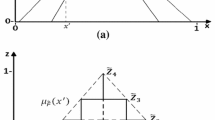Abstract
In this paper we present a design of a student model based on generic fuzzy inference design. The membership functions and the rules of the fuzzy inference can be fine-tuned by the teacher during the learning process (run time) to suit the pedagogical needs, creating a more flexible environment. The design is used to represent the learner’s performance. In order to test the human computer interaction of the system, a prototype of the system was developed with limited teaching materials. The interaction with the first prototype of the system demonstrated the effectiveness of the decision making using fuzzy inference.
Access this chapter
Tax calculation will be finalised at checkout
Purchases are for personal use only
Preview
Unable to display preview. Download preview PDF.
Similar content being viewed by others
References
Hatzilygeroudis, I., Prentzas, J., (2004), “Using a hybrid rule-based approach in developing an intelligent tutoring system with knowledge acquisition and update capabilities”, Expert Systems with Applications, Vol. 26, pp. 477–492.
Hartley, J., Sleeman, D., (1973), “Toward more intelligent teaching systems”, International Journal of Man-Machine studies, pp. 215-236.
Karlstrom, P., Pargman, T., Ramberg, R., (2005), “Designing for Collaboration in Intelligent Computer Assisted Language Learning”, 5th IEEE International Conference on Advanced Learning Technologies (ICALT'05), pp. 321-322.
Kseibat, D., Mansour, A., Adjei, O., Onley, P., (2007), “A Prototype for the Design of Intelligent Tutoring Systems for Teaching Modern Standard Arabic Language”, IASK, E-Activity and Leading Technologies, 2-6 DEC, Porto, Portugal.
Sanchez–Torrubia, M., Torres–Blanc, C., Krishnankutty, S., (2008), “Mamdani’s Fuzzy Inference eMathTeacher: A Tutorial for Active Learning”, WSEAS transactions on computers, Vol. 7.
Nedic, Z., Nedic, V., Machotka, J., (2002), “Intelligent Tutoring System for teaching 1st year engineering”, World Transactions on Engineering and Technology Education, Vol. 1, No.2.
Negoita, M., Pritchard, D., (2004), “Using a virtual student model for testing intelligent tutoring systems”, Interactive Technology and Smart Education, Vol. 1, 195–203, Troubador Publishing Ltd.
Stathacopoulou, R., Magoulas, G., Grigoriadou, M., Samarakou, M., (2005), “Neuro-fuzzy knowledge processing in intelligent learning environments for improved student diagnosis”, Information Sciences, pp. 273-307.
Chen, C., Hong, C., Chen, S., Liu, C., (2006), “Mining Formative Evaluation Rules Using Web-based Learning Portfolios for Web-based Learning Systems”, Educational Technology & Society, Vol. 9, No. 3, pp. 69-87.
Nykanen, O., (2006), “Inducing Fuzzy Models for Student Classification”, Educational Technology and Society, Vol. 9, No. 2, pp. 223-234.
Stathacopoulou, R., Grigoriadou, M., Samarakou, M., Mitropoulos, D., (2007), “Monitoring students' actions and using teachers' expertise in implementing and evaluating the neural network-based fuzzy diagnostic model”, Expert Syst. Appl. Vol. 32, No. 4.
Esposito, F., Licchelli, O., Semeraro, G., (2004), “Discovering Student Models in e-learning Systems”, Journal of Universal Computer Science, vol. 10, no. 1, p. 47-57.
Carmona, C., Castillo, G., Millan, E., (2007), “Discovering Student Preferences in E-Learning”, Proceedings of the International Workshop on Applying Data Mining in e-Learning, ADML-07, pp. 33-43.
Murray, T., Ainsworth, S., and Blessing, S., (2003), “Authoring Tools for Adv. Tech. Learning Env”, Kluwer Academic Publishers. pp. 493–546.
Anderson, T., (2008), “The theory and practice of learning”, Second Edition, AU press, Canada.
Luppicini, R., (2007), "Learning Communities in Online Education", Information Age Publishing.
Author information
Authors and Affiliations
Corresponding author
Editor information
Editors and Affiliations
Rights and permissions
Copyright information
© 2010 Springer Science+Business Media B.V.
About this paper
Cite this paper
Kseibat, D., Mansour, A., Adjei, O., Phillips, P. (2010). Student Model Based on Flexible Fuzzy Inference. In: Sobh, T., Elleithy, K. (eds) Innovations in Computing Sciences and Software Engineering. Springer, Dordrecht. https://doi.org/10.1007/978-90-481-9112-3_7
Download citation
DOI: https://doi.org/10.1007/978-90-481-9112-3_7
Published:
Publisher Name: Springer, Dordrecht
Print ISBN: 978-90-481-9111-6
Online ISBN: 978-90-481-9112-3
eBook Packages: Computer ScienceComputer Science (R0)




